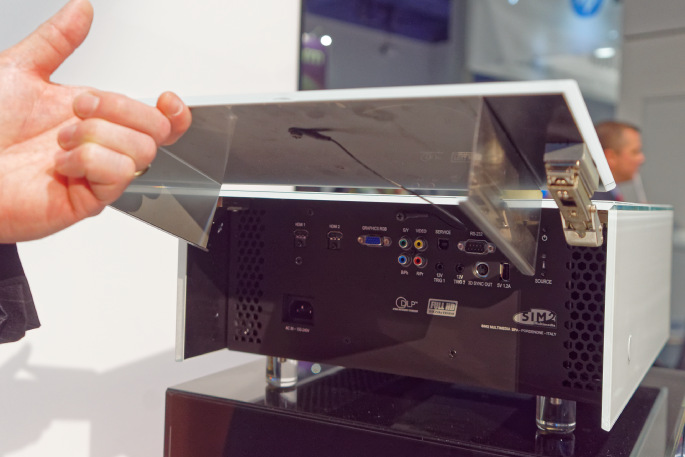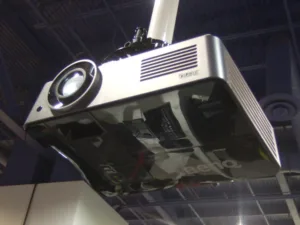 If a film-based privacy filter isn’t enough, 3M is offering its facial-recognition-based ePrivacy filter. (Graphic: 3M)In addition to the expected optical enhancement and privacy films being shown by 3M at its booth in South Hall, the company also showed something unexpected: the “3M ePrivacy Filter.” 3M’s rep told me that customers of the company’s privacy films, which prevent people to your right or left from viewing your laptop or tablet screen, suggested to 3M that they would also like protection from people who might be looking over their shoulders. 3M came up with a software solution that uses the laptop’s camera to detect faces and blur the screen if the face has not been included in a whitelist. The software also blurs the screen when you walk way from the computer. 3M intends the solution to be used in conjunction with one of its privacy films for maximum security.
If a film-based privacy filter isn’t enough, 3M is offering its facial-recognition-based ePrivacy filter. (Graphic: 3M)In addition to the expected optical enhancement and privacy films being shown by 3M at its booth in South Hall, the company also showed something unexpected: the “3M ePrivacy Filter.” 3M’s rep told me that customers of the company’s privacy films, which prevent people to your right or left from viewing your laptop or tablet screen, suggested to 3M that they would also like protection from people who might be looking over their shoulders. 3M came up with a software solution that uses the laptop’s camera to detect faces and blur the screen if the face has not been included in a whitelist. The software also blurs the screen when you walk way from the computer. 3M intends the solution to be used in conjunction with one of its privacy films for maximum security.
Access showed its Netfront Browser BE supporting the DLNA VidiPath remote user interface guidelines. The integration of VidiPath means that Android devices will be able to reach operators’ streaming services for Hollywood studio content.
The Alliance for Wireless Power (A4WP) has begun a merger with the Power Matters Alliance (PMA). The move follows the signing of a liason agreement last February (Display Monitor Vol 21 No 9). The combined board will host some major companies, including Intel, Qualcomm, Starbucks and Duracell. The merger will be completed around mid-2015, and development of PMA’s inductive charging method is expected to continue until at least that point. Rezence (the A4WP’s magnetic resonance technology) is now strong enough to charge laptops; compatible products will begin to appear in the middle of the year.
A 75″ version of Bang & Olufsen‘s Beovision Avant TVs was launched. The Avant 75 uses a direct-LED backlight, like the 85″ model (Display Monitor Vol 21 No 36), and will be available in February starting at €11,200 (ex VAT) with the Beoremote One. The motorised floor stand and wall bracket will add an additional €1,680 (ex VAT).
BenQ introduced just one display product at CES: a colour-calibrated projector with a focus on colour accuracy. The HC1200 (Display Monitor Vol 21 No 46) was developed after a meeting with the CTO of one of the world’s top animation studios at SIGGRAPH 2014. The focus is colour, rather than brightness; while there are many monitors for colour-critical work, there are very few (if any) DLP projectors. The HC1200 has 2,800 lumens of brightness but is factory calibrated to 100% sRGB; it will remain calibrated for “at least” the entire lifetime of the product (seven years).
Blackberry introduced a new IoT device called the Hbox; a portable medical data unit built on the QNX platform, which connects to Blackberry’s IoT platform and securely collects data from wireless medical devices and sensors. The company also showed a version of its Blackberry Messenger software for Android Wear and announced US pricing for the Blackberry Passport ($650) and Classic ($420). No release dates yet, though.
Broadcom was talking about improvements in WiFi and Docsis 3.1. The firm also announced two new chips, the BCM7251S and BCM7252S that support the VP9 and HEVC codecs for UltraHD up to 60Hz, or four 1080P streams. There are dual 2D GPUs (BCM7251S) and a dual core Brahma15 10K DMIPS CPU. The BCM7252S has a 2.7Gpix/s 3D OGLES3.1 GPU.
Last year Cima Nanotech came out of ‘stealth mode’ to reveal its Sante silver-based nanoparticle ink technology. At its Venetian suite this year, the company was showing the large screen sizes that the ink can be applied to to enable procap touch. These included a 57″ multi-touch table and 42″ signage display. Cima says that the current maximum size for the Sante technology is 105″.
An in-car HUD called Iriswas being demonstrated by DD Technologiesbefore its market launch. The HUD projects mobile communications and navigation data onto the windscreen, controlled through finger gestures. It is based on a laser scanning technology, which adapts to ambient light. The Iris device attaches to a driver’s sun visor.
As well as the devices it showed at Pepcom (see our additional coverage of the event for more), Dell was showing an updated version of the Inspiron 15 7000 and 15 5000 laptops. Both now have Intel Broadwell processors, and the 15 7000 has an optional UltraHD display.
The Nabi Big Tab line, from Fuhu (Display Monitor Vol 21 No 33), was expanded to new sizes: 32″, 43″, 55″ and 65″. Fuhu also introduced its own GoPro rival called the Nabi Square HD, which can record in UltraHD.
The danger of any international show is that brands will show old products and hope that you don’t recognise them. Such was the case with Huawei. The company presented the Talkband B1 wearable (Display Monitor Vol 21 No 25) and Honor 6 Plus smartphone (Display Monitor Vol 21 No 50) as new, because they had not been launched in the USA. Even the Ascend Mate 7, the company’s newest product, is already available in China. The Ascend Mate 7 is a 6″ LCD phablet with 1920 x 1080 resolution and in-cell touch, now available in the USA.
There were a lot of TVs on Konka‘s stand, but only two new models: a curved UltraHD OLED (X90) and a 65″ model using auto-stereoscopic 3D technology from Stream TV Networks. Both will be released towards the end of 2015. The 55″ and 65″ OLED sets (OLED55X90P and OLED65X90PU) feature DVB-T and -T2 tuners, ISDB and Android 4.2.
China’s Linktop showed an analogue watch, the U2, with a transparent colour OLED display over the face, providing smart functionality (much like the Halo smartwatch from Longshine, released last year (Display Monitor Vol 21 No 40)). Battery life for the display is said to be as long as 30 days. The watch will connect to a smartphone via Bluetooth.
Last year, Marvell impressed us with its HDMI dongle which was able to run a full Android system. We asked about developments, but Marvell had no news on this. The firm was keen to talk about a design win with China Telecom that could mean more than 25 million of the firm’s users starting to use G.hn powerline technology. Skyworth was showing a TV with G.hn in the main show, we heard.
CES 2015 marked the first time that Oculus VR was showing its immersive 3D audio to anyone outside the company. Demonstrations were being combined with showings of the Crescent Bay prototype (Display Monitor Vol 21 No 38). Crescent Bay is widely thought to be using the same OLED display (2560 x 1440) used in Samsung’s Galaxy Note 4, at an impressive 90fps.
OmniVision Technologies announced that its new OVP7200 and OVP921 LCoS chipsets will be used in a HuD developed by the Hong Kong Applied Science and Technology Research Institute (ASTRI). The new HUD is designed for use in next-generation automobiles. The OVP7200 is a 0.37″ single panel, field-sequential LCoS device with 1280 x 720 resolution. The OVP921 is a companion chip providing image processing capabilities.
SetTop Box maker, Pace, was not on our list for the show, but we spotted a sign that mentioned UltraHD as we went past the door of the suite, so we popped in. The company had a very small device that supports UltraHD (P30) and includes 2 x 4 antenna 802.11ac Wi-fi. The box runs full Android (KitKat), has HDMI in and out and takes just 4.5W of power. There’s 1G of RAM and flash is supplied by an SD slot. The unit is ready for production if a customer wanted it.
As well as the cameras we saw at CES Unveiled, Polaroid was demonstrating new 7″ and 10.1″ L-series tablets: the L7 and L10. These are US-only, with quad-core processors and Android 5.0. They will be launched in the spring, costing between $100 and $150. There was also a 65″ UltraHD TV, using an Innolux panel, joining the 42″ and 55″ models launched at the end of last year. It will be available in the spring for $2,000.
Reticare, which specialises in filters for monitors and tablets to reduce blue light told us that it has extended the sizes that it can cover and can support up to 27″ displays now. The company is looking to move into TVs before long and will support sets up to 65″.
New UltraHD TVs, from 50″ – 84″, were shown off by Sceptre in The Bellagio. These new TVs feature HDMI ports capable of transferring high-res signals at 60fps. The company is entering the UltraHD market in a big way, also showing 50″ – 65″ touch displays and a 28″ monitor.
Seiki was showing off some new UltraHD monitors at IFA 2014, and plans to enter the category with finished products in Q1 this year. Two new monitors were introduced, in 32″ and 40″ sizes. They are known as the SM32UNP and SM40UNP and will be part of the ‘Seiki Pro’ line. Both will feature DisplayPort (1.2, upgrading to 1.3 in Q2), MHL (3.0)-HDMI (with UltraHD at 60fps in Q2), DVI and VGA ports. Panels will be VA types. The monitors will also have a USB hub (2 down/1 up). Specific pricing was not shared, but Seiki said that the 40″ model would cost less than $1,000.

Skyworth was demonstrating the S900C UltraHD OLED TV, which is already available in China, in 55″ and 65″ sizes. Depending on the domestic reaction, it will be launched worldwide in the middle of 2015. We noticed that the 55″ unit has a much shallower curve than the 65″, which is apparently due to “panel limitations” (although LG’s curved OLED TVs, which presumably use the same panel, have a much more significant curve). A slim (7.9mm) TV was also on show, called the Air TV; it is 49″ with UltraHD resolution, but has no release date. Finally, Konka was showing a 65″ auto-stereoscopic 3D using Stream TV Networks’ technology.
 The Sim 2 Nero projector has a cover over the connectors to keep things looking neatWe bumped into Sim 2 on the Sisvel booth. Sisvel was at the show to see licencees and customers, so was not showing the 3D technology it has been promoting. However, on the corner of the booth we found Sim 2 which was showing its Nero 3 projector (Display Monitor Vol 21 No 36) – a very stylish unit that is aimed at mid-high end home cinema installations and costs from $14,000 (depending on lens configuration). It has 2,000 Ansi lumens of brightness and uses LED lamps. We suggested that the name Nero might have been chosen because of the heat from the LEDs! Sim 2, of course, makes the very high dynamic range 47″ LED-backlit monitors that can be used for HDR grading (and take 1.8 KW of power!). We heard that Samsung has bought one and Apple has bought three, so there must be something happening in HDR in Cupertino!
The Sim 2 Nero projector has a cover over the connectors to keep things looking neatWe bumped into Sim 2 on the Sisvel booth. Sisvel was at the show to see licencees and customers, so was not showing the 3D technology it has been promoting. However, on the corner of the booth we found Sim 2 which was showing its Nero 3 projector (Display Monitor Vol 21 No 36) – a very stylish unit that is aimed at mid-high end home cinema installations and costs from $14,000 (depending on lens configuration). It has 2,000 Ansi lumens of brightness and uses LED lamps. We suggested that the name Nero might have been chosen because of the heat from the LEDs! Sim 2, of course, makes the very high dynamic range 47″ LED-backlit monitors that can be used for HDR grading (and take 1.8 KW of power!). We heard that Samsung has bought one and Apple has bought three, so there must be something happening in HDR in Cupertino!
Syndiant showed a head-mounted display using its own SYL2271 LCoS microdisplay architecture, with 1280 x 720 resolution. The display appears as an 80″ image from 4.5m. A companion media control box, running Android 4.4, was also shown, with a battery to power the HMD.
A portable Android projector was shown by Touchpico. The projector is the result of an Indiegogo campaign; it can throw an 80″ image, with interactivity enabled through a special stylus. Mass production will begin in February.
The Wireless Power Consortium‘s Qi inductive charging standard will reach 2.4kW this year and now has a range of up to 10cm. Thanks to communication coils integrated with the inductive charging coils, the signal can be modulated to deliver lower power if necessary – for smartphones, for instance. The range is a big change for the standard, which just two years ago had to have coils set into surfaces – they can now be positioned below worktops.
WiTricity showed off various Rezence solutions from the A4WP. This included a ‘Home of the Future’ concept where the range of wireless power transfer was increased through the use of repeaters hidden under a carpet.

